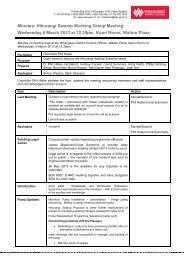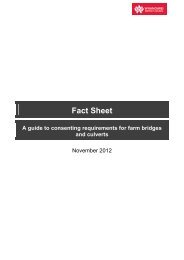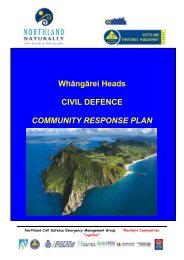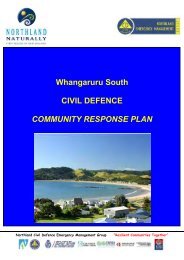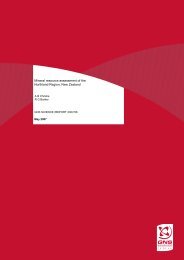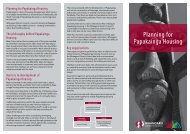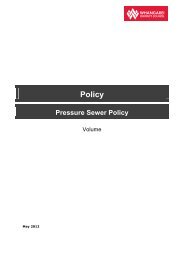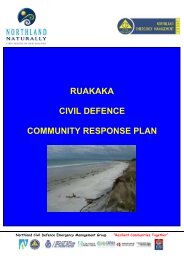Conservation Covenants in Whangarei District
Conservation Covenants in Whangarei District
Conservation Covenants in Whangarei District
You also want an ePaper? Increase the reach of your titles
YUMPU automatically turns print PDFs into web optimized ePapers that Google loves.
Swamp system with small patch of regenerat<strong>in</strong>g<br />
kahikatea<br />
Riparian forest<br />
Forest understory<br />
Further Information<br />
Contact Council Duty Planner or the State of the<br />
Environment Co-ord<strong>in</strong>ator, if you have any queries.<br />
<strong>Covenants</strong> may also be created under the follow<strong>in</strong>g<br />
statutes:<br />
• The Queen Elizabeth the Second National Trust Act<br />
1977, QEII National Trust<br />
www.openspace.org.nz<br />
• Te Ture Whenua Maori Act 1993 (Part 17), Department<br />
of <strong>Conservation</strong><br />
www.doc.govt.nz<br />
<strong>Conservation</strong><br />
<strong>Covenants</strong><br />
<strong>in</strong> <strong>Whangarei</strong> <strong>District</strong><br />
Regenerat<strong>in</strong>g broadleaf forest / podocarp<br />
<strong>Whangarei</strong> <strong>District</strong> Council<br />
Private Bag 9023, <strong>Whangarei</strong> 0148<br />
Forum North, Rust Avenue, <strong>Whangarei</strong><br />
Phone: 09 430 4200<br />
Facsimile: 09 438 7632<br />
Toll Free: 0800 WDC INFO (0800 932 463)<br />
Email: mailroom@wdc.govt.nz<br />
Website: www.wdc.govt.nz<br />
Month Year
<strong>Conservation</strong> <strong>Covenants</strong> <strong>in</strong> <strong>Whangarei</strong> <strong>District</strong><br />
A conservation covenant is a voluntary agreement made<br />
between a landowner and an authorised body, for the<br />
purposes of protect<strong>in</strong>g and enhanc<strong>in</strong>g the natural, cultural,<br />
historical and/or significant values of a site. The landowner<br />
cont<strong>in</strong>ues to own the site, while meet<strong>in</strong>g their responsibilities<br />
to ensure the values of the site are conserved.<br />
What can be protected<br />
Sites with ecological, cultural, and historical values and<br />
significance can be protected by a conservation covenant.<br />
With<strong>in</strong> the <strong>Whangarei</strong> <strong>District</strong> native bush and wetlands sites<br />
make up the majority of conservation covenants.<br />
Benefits<br />
<strong>Covenants</strong> are a good example of members of the<br />
community work<strong>in</strong>g with Council to protect and enhance<br />
biodiversity values and habitat for threatened species with<strong>in</strong><br />
the district.<br />
<strong>Covenants</strong> can improve the stability of a site e.g. reduce<br />
erosion, contribute to form<strong>in</strong>g ecological corridors, as well<br />
as provision of ecosystem services, e.g. nutrient recycl<strong>in</strong>g,<br />
filter<strong>in</strong>g ra<strong>in</strong> and runoff, improv<strong>in</strong>g water quality and store<br />
carbon (climate regulation).<br />
Establish<strong>in</strong>g a conservation covenant with the Council is an<br />
opportunity to formalise the protection of a site, <strong>in</strong> perpetuity.<br />
Such protection can <strong>in</strong>crease surround<strong>in</strong>g property values<br />
along with natural, cultural and historic values.<br />
In enter<strong>in</strong>g <strong>in</strong>to a conservation covenant, landowners receive<br />
rates relief from the Council for the area of the site that is<br />
covenanted, and assistance with ecological and technical<br />
advice.<br />
Establish<strong>in</strong>g a Covenant with the <strong>Whangarei</strong><br />
<strong>District</strong> Council<br />
The <strong>Whangarei</strong> <strong>District</strong> Council is authorised under Section<br />
77 of the Reserves Act 1977, to establish conservation<br />
covenants <strong>in</strong> respect of private land for the purpose<br />
of manag<strong>in</strong>g such sites so as to preserve the natural<br />
environment, landscape amenity, wildlife, fresh water life,<br />
mar<strong>in</strong>e life habitat, or historical value of the sites.<br />
Under rule 73.3.2, Environmental Benefit, of the <strong>District</strong><br />
Plan, a covenant may be established as part of a subdivision<br />
development with<strong>in</strong> Countryside and Coastal Countryside<br />
Environments, to secure permanent protection and/or<br />
enhancement of:<br />
• Stands of <strong>in</strong>digenous vegetation or <strong>in</strong>digenous fauna<br />
habitat, <strong>in</strong>clud<strong>in</strong>g <strong>in</strong>digenous wetlands;<br />
• Areas of appropriately designed <strong>in</strong>digenous re-vegetation<br />
or enhancement.<br />
Where such protection/enhancement is offered, the number of<br />
environmental benefit lots that can be obta<strong>in</strong>ed is related to the<br />
value and areal extent of the items that are to be protected. A<br />
covenant may also be, and often is, established as part of any<br />
other subdivision proposal.<br />
There are costs <strong>in</strong>volved <strong>in</strong> establish<strong>in</strong>g a covenant which<br />
<strong>in</strong>clude, but are not limited to, application fees, survey<strong>in</strong>g and<br />
legal costs, and register<strong>in</strong>g the covenant on the property title.<br />
These costs are the responsibility of the landowner/s.<br />
There are approximately 875 conservation covenants <strong>in</strong> the<br />
<strong>Whangarei</strong> <strong>District</strong>, cover<strong>in</strong>g 1,307ha area. These make an<br />
important contribution to protect<strong>in</strong>g natural, cultural and historic<br />
values of the district. There are also 298 QEII covenants <strong>in</strong> the<br />
district cover<strong>in</strong>g 2,426.63ha area and five Nga Whenua Rahui<br />
covenants cover<strong>in</strong>g an area of 76ha.<br />
Covenantor’s Responsibilities<br />
The landowner of the site covenanted, is responsible for its<br />
management. Some fund<strong>in</strong>g maybe obta<strong>in</strong>ed for assistance<br />
with fenc<strong>in</strong>g and pest control, although this is not guaranteed.<br />
Landowner responsibilities may <strong>in</strong>clude:<br />
• Undertak<strong>in</strong>g pest and weed management.<br />
• Ma<strong>in</strong>tenance of access tracks and perimeter fences.<br />
• Encourag<strong>in</strong>g the regeneration of native vegetation.<br />
The land owner is responsible for ensur<strong>in</strong>g that the site<br />
is preserved. Any activities undertaken on or with<strong>in</strong> the<br />
conservation area that contravene the preservation of the site<br />
will require the Council’s prior written approval.<br />
Monitor<strong>in</strong>g<br />
Ecological monitor<strong>in</strong>g of the covenant is carried out by the<br />
Council, preferably 10 years from the date of agreement and<br />
then subsequently at 10 yearly <strong>in</strong>tervals. Monitor<strong>in</strong>g is carried<br />
out to assess the state of the covenant and offer advice to<br />
the land owners concern<strong>in</strong>g management for protect<strong>in</strong>g the<br />
ecological and/or other values.<br />
Broadleaf / podocarp forest<br />
Regenerat<strong>in</strong>g forest understory<br />
Raupo swamp




